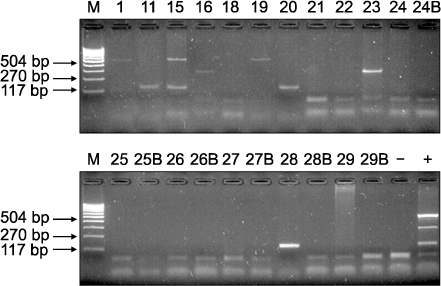Tuberc Respir Dis.
2008 Mar;64(3):194-199. 10.4046/trd.2008.64.3.194.
Multiplex PCR of Endotracheal Aspirate for the Detection of Pathogens in Ventilator Associated Pneumonia
- Affiliations
-
- 1Department of Internal Medicine, College of Medicine, Chung-Ang University, Seoul, Korea. jykimmd@cau.ac.kr
- 2Department of Urology, College of Medicine, Chung-Ang University, Seoul, Korea.
- 3Department of Cell Genomics, College of Medicine, Chung-Ang University, Seoul, Korea.
- KMID: 1478180
- DOI: http://doi.org/10.4046/trd.2008.64.3.194
Abstract
-
BACKGROUND: Early identification of pathogens can improve the prognosis of patients with ventilator associated pneumonia (VAP). In the present study, we evaluated the feasibility of performing multiplex PCR for endotracheal aspirates to detect three important pathogens (P. aeruginosa, K. pneumoniae and MRSA) in patients with VAP.
METHODS
The endotracheal aspirates of 24 patients were collected within 24 hours of the diagnosis of VAP for performing multiplex PCR. Forward and reverse primers were designed to target the specific site of each pathogen (the oprL gene for P. aeruginosa, 16S rRNA for K. pneumoniae and the mec gene for MRSA). We analyzed the clinical data of the VAP patients, including the culture reports for the endotracheal aspirates.
RESULTS
Twenty-four patients (M:F=18:6, mean age=70+/-11) with VAP were enrolled. Pathogens were isolated from 11 patients (P. aeruginosa in 2, K. pneumoniae in 1, MRSA in 2, other enteric Gram negative bacilli in 3, S. pneumoniae in 2 and mixed infection in 1). Multiplex PCR detected three cases of P.aeruginosa (2 cases coincided with the culture reports) and four cases of K. pneumoniae (1 matched with the culture report). PCR detected two MRSA cases, which did not coincide with the culture reports.
CONCLUSION
Multiplex PCR of the endotracheal aspirate showed some ability to detect Gram negative bacilli, although caution is required when interpreting the results.
MeSH Terms
Figure
Reference
-
1. Craven DE, Palladino R, McQuillen DP. Healthcare-associated pneumonia in adults: management principles to improve outcomes. Infect Dis Clin North Am. 2004. 18:939–962.2. American Thoracic Society. Infectious Disease Society of America. Guidelines for the management of adults with hospital-acquired, ventilator-associated, and healthcare-associated pneumonia. Am J Respir Crit Care Med. 2005. 171:388–416.3. Rosenthal VD, Guzman S, Migone O, Safdar N. The attributable cost and length of hospital stay because of nosocomial pneumonia in intensive care units in 3 hospitals in Argentina: a prospective, matched analysis. Am J Infect Control. 2005. 33:157–161.4. Craven DE, Steger KA. Epidemiology of nosocomial pneumonia. New perspectives on an old disease. Chest. 1995. 108:1S–16S.5. Meduri GU. Diagnosis and differential diagnosis of ventilator-associated pneumonia. Clin Chest Med. 1995. 16:61–93.6. Andrews CP, Coalson JJ, Smith JD, Johanson WG Jr. Diagnosis of nosocomial bacterial pneumonia in acute, diffuse lung injury. Chest. 1981. 80:254–258.7. Meduri GU, Chastre J. The standardization of bronchoscopic techniques for ventilator-associated pneumonia. Chest. 1992. 102:557S–564S.8. Baselski VS, el-Torky M, Coalson JJ, Griffin JP. The standardization of criteria for processing and interpreting laboratory specimens in patients with suspected ventilator-associated pneumonia. Chest. 1992. 102:571S–579S.9. Moon DS, Lim CM, Pai CH, Kim MN, Chin JY, Shim TS, et al. Study for diagnostic efficacy of mini-bronchoalveolar lavage in the detection of etiologic agents of ventilator-associated pneumonia in patients receiving antibiotics. Tuberc Respir Dis. 1999. 47:321–330.10. Porzecanski I, Bowton DL. Diagnosis and treatment of ventilator-associated pneumonia. Chest. 2006. 130:597–604.11. Duan K, Lafontaine ER, Majumdar S, Sokol PA. RegA, iron, and growth phase regulate expression of the Pseudomonas aeruginosa tol-oprL gene cluster. J Bacteriol. 2000. 182:2077–2087.12. Pingle MR, Granger K, Feinberg P, Shatsky R, Sterling B, Rundell M, et al. Multiplexed identification of blood-borne bacterial pathogens by use of a novel 16S rRNA gene PCR-ligase detection reaction-capillary electrophoresis assay. J Clin Microbiol. 2007. 45:1927–1935.13. Ito T, Kuwahara K, Hiramatsu K. Staphylococcal cassette chromosome mec (SCC mec) analysis of MRSA. Methods Mol Biol. 2007. 391:87–102.14. Ranes JL, Gordon SM, Chen P, Fatica C, Hammel J, Gonzales JP, et al. Predictors of long-term mortality in patients with ventilator-associated pneumonia. Am J Med. 2006. 119:897.e13–897.e19.15. Luna CM, Aruj P, Niederman MS, Garzon J, Violi D, Prignoni A, et al. Appropriateness and delay to initiate therapy in ventilator-associated pneumonia. Eur Respir J. 2006. 27:158–164.16. Stralin K, Tornqvist E, Kaltoft MS, Olcen P, Holmberg H. Etiologic diagnosis of adult bacterial pneumonia by culture and PCR applied to respiratory tract samples. J Clin Microbiol. 2006. 44:643–645.17. Rello J, Lorente C, Diaz E, Bodi M, Boque C, Sandiumenge A, et al. Incidence, etiology, and outcome of nosocomial pneumonia in ICU patients requiring percutaneous tracheotomy for mechanical ventilation. Chest. 2003. 124:2239–2243.18. Cowen JS, Kelley MA. Errors and bias in using predictive scoring systems. Crit Care Clin. 1994. 10:53–72.19. Escarce JJ, Kelley MA. Admission source to the medical intensive care unit predicts hospital death independent of APACHE II score. JAMA. 1990. 124:2389–2394.20. Knaus WA, Wagner DP, Draper EA, Zimmerman JE, Bergner M, Bastos PG, et al. The APACHE III prognostic system: risk prediction of hospital mortality for critically ill hospitalized adults. Chest. 1991. 100:1619–1636.
- Full Text Links
- Actions
-
Cited
- CITED
-
- Close
- Share
- Similar articles
-
- Clinical Evaluation of the Multiplex PCR Assay for the Detection of Bacterial Pathogens in Respiratory Specimens from Patients with Pneumonia
- Evaluation of Seeplex(TM) Pneumobacter Multiplex PCR Kit for the Detection of Respiratory Bacterial Pathogens in Pediatric Patients
- Evaluation of the BioFire FilmArray Pneumonia Panel for the Detection of Bacterial Respiratory Pathogens and Antimicrobial Resistance Genes in Endotracheal Aspirate Specimens
- A Comparative Study of Endotracheal Aspirates and Protected Specimen Brush in the Quantitative Cultures of the Ventilator-Associated Pneumonia
- Incidence of Colonization, Ventilator-Associated Pneumonia as Related to the Type of Endotracheal Suction System in Mechanically Ventilated Patients


